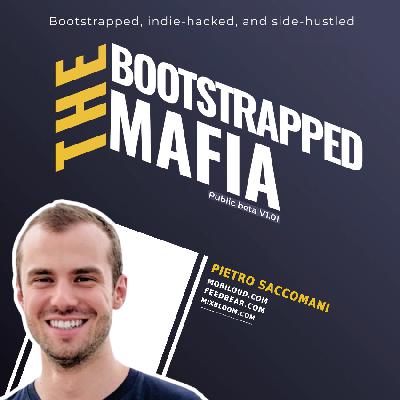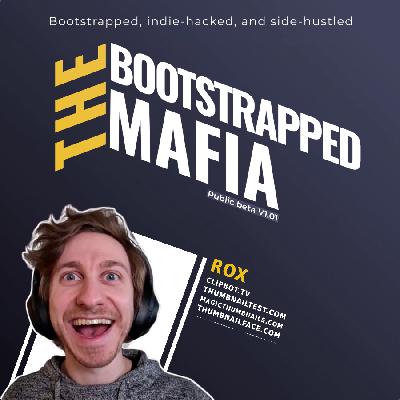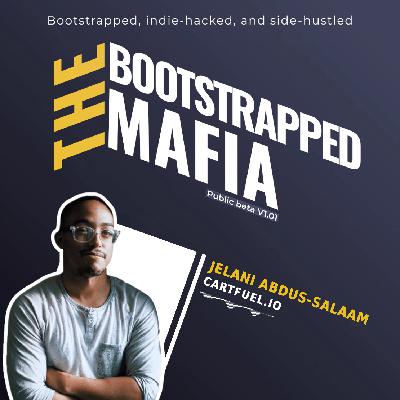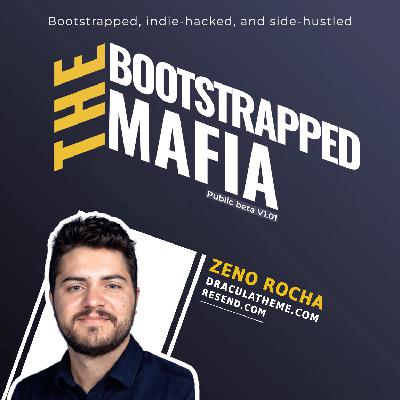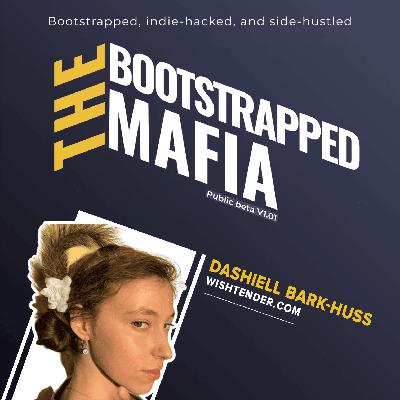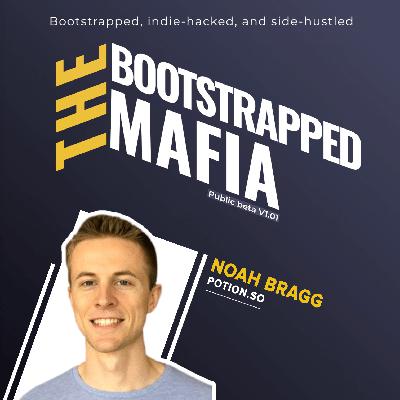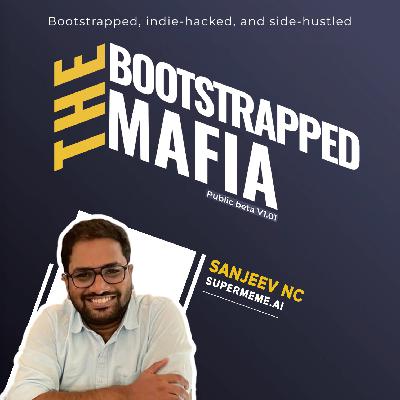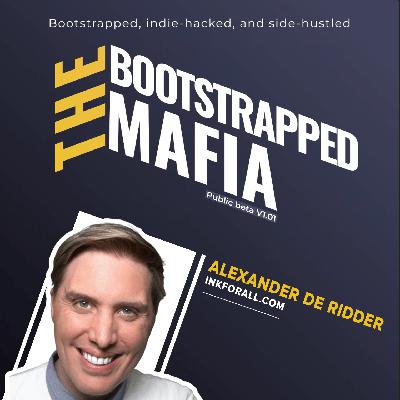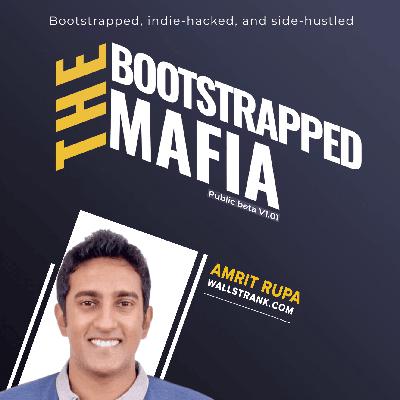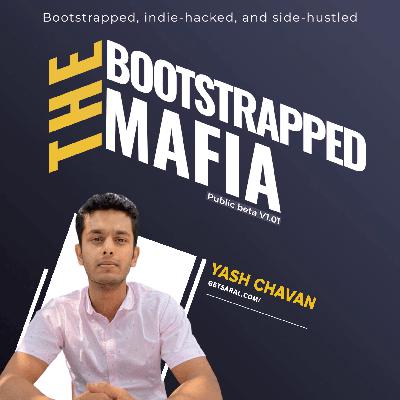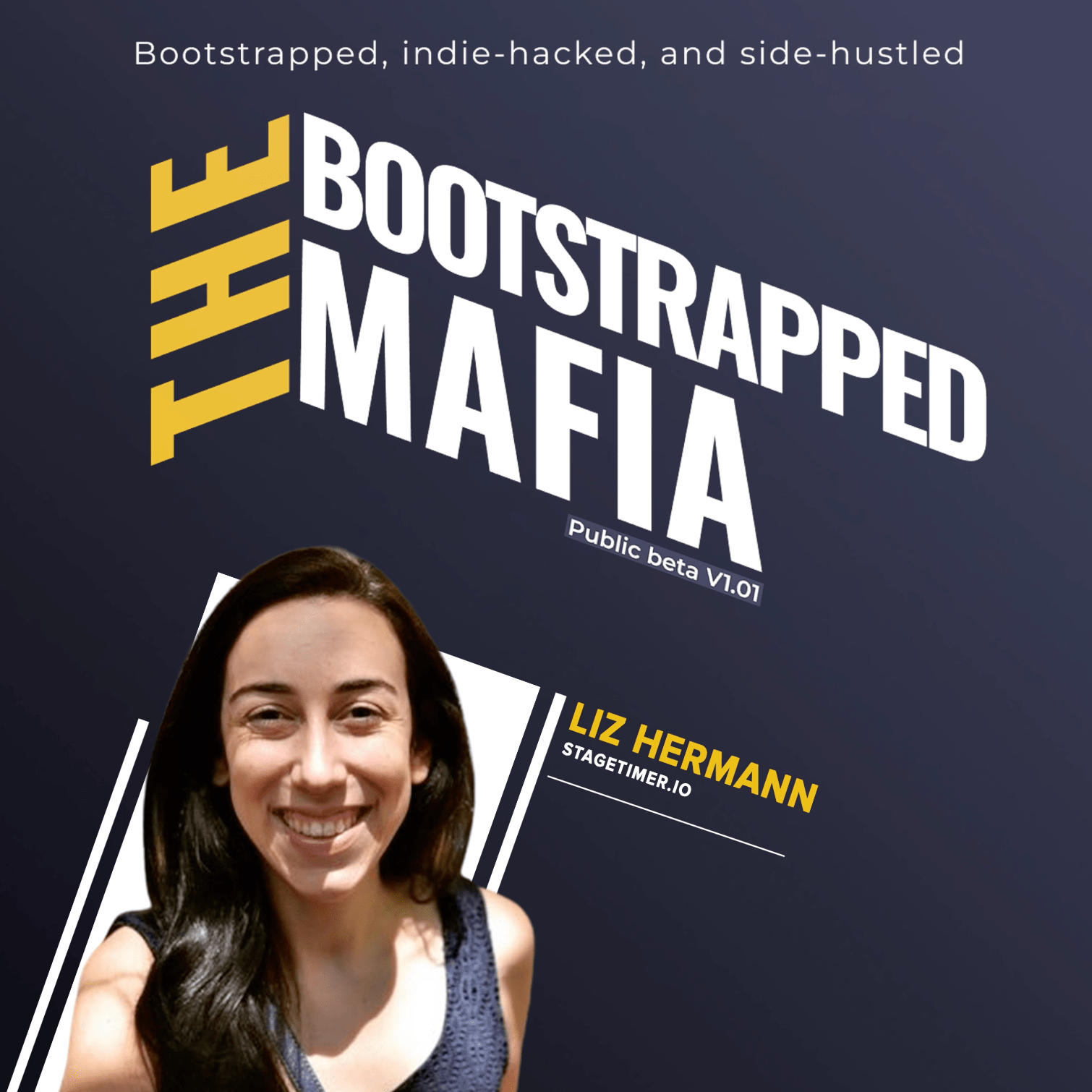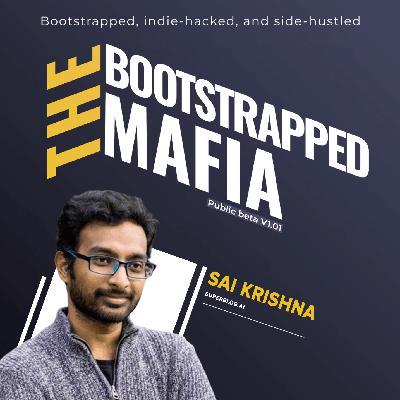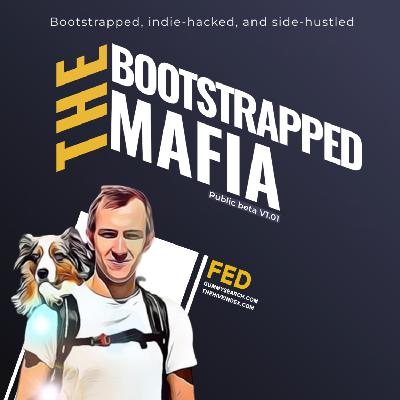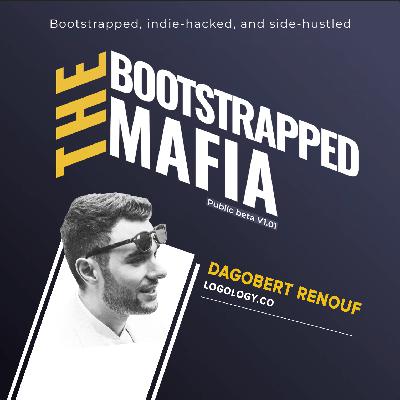Discover The Bootstrapped Mafia
The Bootstrapped Mafia

21 Episodes
Reverse
Aprilynne built up a YouTube channel from zero to over twenty two K subscribers last year. But she is starting all over again. No subscribers, no videos, no monetization, nothing. Her goal is to get Youtube monetised in 30 days. Will she make it? Let’s keep an eye.
Key Takeaways
[01:30] - Why skipping the Wall Street for a better life.
[04:20] - What is better, a corporate life or being a startup founder.
[05:22] - How to go from 0 to monetisation on YouTube.
[07:58] - How to make $10,000 before the launch.
[12:10] - How does reputation play in YouTube success.
[14:30] - How to build and profit for a YouTube channel.
[18:02] - Results after 9 months of YouTubing for bootstrapping founders.
[20:11] - Getting 1,000 followers on YouTube fast.
[22:41] - What equipment you need to start on YouTube.
[25:45] - 6 figures as a YouTuber and indie hacker.
Links
Follow the journey:
LinkedIn: linkedin.com/in/aprilynne
Twitter: twitter.com/AprilynneAlter
dumpl.ink/aprilynnealter- Sharing insights and struggles as a full-time creator
Book with insights: Navigating The Bootstrapped Mafia
Connect with Bulat:
LinkedIn: linkedin.com/in/thebulatk
Twitter: twitter.com/thebulatk
Pietro is a serial founder bootstrapping mobiloud.com, feedbear.com and mixbloom.com with a mind-blowing goal of moving from $1.5M to $5M ARR in 3 years. This is probably not for all indie hackers, but it is an amazing situation to be in.
Key Takeaways
[01:23] - A path from consulting to building digital products.
[02:31] - "Go big or Go home" VS "Make customers happy" mentality.
[03:45] - A path to serial bootstrapped entrepreneurships.
[07:03] - What are the downsides of running multiple businesses.
[08:40] - Team set up for an effective business management.
[09:51] - "Indie hacking a business" VS "Bootstrapping a business" worlds.
[11:13] - When bootstrapping founders should start hiring people.
[14:22] - Focus on high-level strategy and team support.
[16:53] - Where to find the first paying users for a product startup.
[19:31] - Exploring the market by talking to customers.
[21:23] - How many customers do you need? and other considerations before you start.
[22:45] - How the explosion of AI challenges all bootstrapping founders.
[24:45] - How to work with AI as a bootstrapped digital product business.
Quotes
“I want a business that I've built to work for me.“ - Pietro
“ As quickly as I can, I want to get out of execution. “ - Pietro
“I enjoyed the business more when I build a team around myself.“ - Pietro
“As soon as you can afford it, bring new people.“ - Pietro
“Fire yourself from the customer support. It creates a lot of stress and takes a lot of time.“ - Pietro
“Everything should really start from customer interviews, customer surveys and talking to people.“ - Pietro
“The healthiest thing to do is to talk to customers.“ - Pietro
Links
Follow the journey:
LinkedIn: linkedin.com/in/pietrosaccomani
Twitter: twitter.com/psaccomani
MobiLoud.com- Turn your website into a mobile app in under 2 weeks
FeedBear.com- Collect and Prioritize Customer Feedback the Easy Way
MixBloom.com- Scale Your Agency with Quality Social Media Content
Book with insights: Navigating The Bootstrapped Mafia
Connect with Bulat:
LinkedIn: linkedin.com/in/thebulatk
Twitter: twitter.com/thebulatk
Rox worked for MrBeast, Facebook, Microsoft, and other companies. Now, he helps big creators start software businesses while trying to live the most amazing life he can. He makes content about what he builds so you can follow it.
Key Takeaways
[01:12] - How to exit everything and bootstrap a SaaS product from Thailand.
[03:26] - How to make money from a startup on day one and ship quickly supports development.
[04:19] - Making money as a bootstrapped startup money.
[05:09] - What are the downsides of a long product launch.
[06:25] - How to validate a product idea without validating a product idea.
[08:49] - How to choose the pricing model for a product startup.
[10:09] - How bootstrapped SaaS founders approach scaling and x10 growth.
[14:18] - What are the next steps in the startup journey.
[14:56] - Where to get the paying users for a product startup.
[18:27] - Twitter marketing strategy for a digital product startup.
[19:18] - $1,000,000 worth bootstrapping founder.
[21:11] - Don't mess up.
Quotes
“Now I treat validation generally as either I think it is a great idea and I trust my instinct and I think I can build it quickly, or I'll try and get money upfront for it.“ - Rox
“I try to do a free refund instead of a free trial. Coz I think you prove something different if people give you money. “ - Rox
“A real good tip is to build a real big FAQ. It gets me a real good SEO.“ - Rox
“The more I code, the less I think about marketing and I can't do both. I wanna do no development and all marketing.“ - Rox
“I just need more people using it right now, that's my number one goal. Until then I should not spend my time perfecting it.“ - Rox
“I had to learn a lot of things. The first was to build fast. The second was to not build sh*t.“ - Rox
Links
Follow the journey:
Twitter: twitter.com/RoxCodes
🧪ThumbnailTest.com - A/B Test YT Thumbs
👀ThumbnailCheck.com - Preview Thumbs on YT
✨MagicThumbnails.com - AI YT Thumbs
😄ThumbnailFace.com - Bulk Thumb Faces
Book with insights: Navigating The Bootstrapped Mafia
Connect with Bulat:
LinkedIn: linkedin.com/in/thebulatk
Twitter: twitter.com/thebulatk
Previously, Jelani Abdus-Salaam was the lead VIP tech specialist at ClickFunnels, where he assisted Jay Abraham, Grant Gardone, Tony Robbins, and others. Following his time at ClickFunnels, he worked with high-profile digital entrepreneurs like Dan Lok, Alison Prince, Traffic and Funnels, Beau Crabill, and others, assisting them in developing conversion-optimized funnels, back-end automations, and systems to scale their businesses to multiples of millions.
Jay is now working on CartFuel.io, a technology that assists online businesses in increasing their AOV using conversion-optimized payment forms.
Key Takeaways
[00:40] - How bootstrapping SaaS founder begin their journey.
[01:58] - Cost, team composition, management, and other considerations while developing a SaaS application with outsourced developers.
[03:48] - The issues and constraints of hourly-paid outsourced developers.
[04:53] - CartFuel's MRR and Value Proposition.
[06:13] - Searching the forums to find and validate a worthwhile idea.
[08:28] - Building relationships, estimating costs and utilising UpWork to create an MVP.
[10:32] - Finding the real pain-points of your target users and delivering on it.
[13:08] - Creative cashflow management of non-technical founders.
[14:56] - How to get the first 50+ paying users for a SaaS.
[16:03] - On what to focus and what to track in a digital SaaS startup.
[17:32] - Doing more customer research and finding more pain-points to ship an MVP.
[19:41] - Advice for wannabe entrepreneurs and those with less than $2,000 MRR.
Quotes
“Having two customer segments is a real mistake. You should have one customer segment only.“ - Jay
“All of the work that's being done is paid hourly so you have to manage cashflow.“ - Jay
“Customer success is a number one. If you're able to give that customer the desired outcome that they want and experience specific to them, you are able to scale.“ - Jay
“At $500 MRR, talk to your customer and try to understand why they use your product.“ - Jay
“Don't try to reinvent the wheel. Go and find products that already exist and find negative reviews.“ - Jay
Links
Follow the journey:
Twitter: twitter.com/jelanisince94
LinkedIn: linkedin.com/in/jelaniabdussalaam
Cartfuel: cartfuel.io
Book with insights: Navigating The Bootstrapped Mafia
Connect with Bulat:
LinkedIn: linkedin.com/in/thebulatk
Twitter: twitter.com/thebulatk
Zeno Rocha was a VP of Developer Experience at WorkOS at the time of our conversation, and he also had a handful of successful side projects, like the Dracula theme and React Email. React.email was created to assist developers in creating modern email templates. Zeno dug more and it became evident that this was only the top of the iceberg, since sending emails was the major pain point, so he began to look into other options.
So Zeno quit his full-time job and created Resend, with the intention of assembling an outstanding team of builders. Resend is a messaging platform that began with emails. The goal is to deliver messages using simple APIs/SDKs without having to worry about emails ending up in the spam folder. Consider it a next-generation Sendgrid.
Key Takeaways
[00:46] - The journey of a bootstrapping side hustler.
[04:13] - How to be open and honest with your full-time employer about your side project(s).
[06:33] - TAX optimisation to improving revenue management.
[09:53] - Difficulties in sustaining a SaaS without a technical cofounder.
[11:36] - A side hustle founder's daily hardships and sacrifices.
[13:23] - Bouncing all facets of a startup as a sole founder.
[14:03] - Self-awareness and being honest with yourself.
[15:46] - People should be devoting more time to marketing than to building.
[17:11] - Be patient while waiting for your results.
[18:40] - How to go about your bootstrapped journey without previous experience.
[19:44] - Be kind to yourself when you look at other people.
[21:59] - Discovering unfair advantages for your persona.
Quotes
“When I close my laptop for my FT job at 5PM, at 5:30 I'm opening it again.“ - Zeno
“What matters is being real to who I am.“ - Zeno
“Your product is not going to be as good as you think it's gonna be. That's why it is so important to focus on marketing.“ - Zeno
“It gets years. Five. Ten. Fifteen years. It doesn't take 1 months. 3 months. 7 months. And knowing that is very important early on.“ - Zeno
Links
Follow the journey:
Twitter: twitter.com/zenorocha
LinkedIn: linkedin.com/in/zenorocha/
Resend: resend.com
Book with insights: Navigating The Bootstrapped Mafia
Connect with Bulat:
LinkedIn: linkedin.com/in/thebulatk
Twitter: twitter.com/thebulatk
Alex has sold his bootstrapped startup Taplio to another bootstrapped startup, Lemlist, since we recorded this episode - a big deal in the bootstrapped world. And it wasn't his first venture and entrepreneurship experience. In fact, he exited a few startups already.
Alex is now working on Omni, which assists in the creation and implementation of an Omni Channel outreach system that generates more sales from difficult-to-reach prospects and automatically closes high-quality B2B clients. In just 10 minutes a day.
Key Takeaways
[00:49] - The cold email outreach and pitching superpower.
[02:16] - Co-founding a bootstrapped startup that will be sold.
[03:30] - Serial entrepreneurship and multiple exits story.
[04:15] - Why is it necessary to create marketing hype, push the product, and be consistent?
[07:12] - The synergy of co-founders and the idea validation stage.
[08:16] - Sign-ups struggle after the launch.
[09:25] - Collaborating with influencers via revenue sharing.
[10:38] - Identifying exponential growth channels in order to advance to the next level.
[12:32] - Using an MRR as a success indicator.
[13:55] - Getting money very quickly is the first focus to do.
[14:23] - Startup valuation - how to start from scratch properly.
[16:46] - Entrepreneurial advice for aspiring entrepreneurs.
Quotes
“All I want to do is to get them in the product so they can make this decision.“ - Alex
“The main thing is getting the landing page that converts and collects money.“ - Alex
“Try what works and try make money as soon as possible.“ - Alex
“Your technical skills are worth zero dollars in the early stage of the business. The only thing that matters is customers. That’s the only thing you need to be focused on.“ - Alex
Links
Follow the journey:
Twitter: twitter.com/alxberman
LinkedIn: linkedin.com/in/alexanderberman
Cold Email Manifesto book: Cold Email Manifesto
Omni: omni.us
Book with insights: Navigating The Bootstrapped Mafia
Connect with Bulat:
LinkedIn: linkedin.com/in/thebulatk
Twitter: twitter.com/thebulatk
Dashiell Bark-Huss is incredible. She lived in a van for three years, where she taught herself to code. She created WishTender as a solo developer after a friend suggested it would be useful. After Dashiell launched, her spouse began working with her, and they have bootstrapped the business to 50k+ users in 1.5 years.
WishTender is an international wish list that ensures you receive gift funds quickly and without worry (privately).
Key Takeaways
[00:41] - Learning how to code in 1.5 years in order to launch a SaaS.
[02:25] - An untapped market opportunity - anonymous gifts.
[07:23] - Growing to $30K monthly revenue without prior experience.
[09:05] - Navigating the difficulties of a non-tech entrepreneur.
[12:33] - Manual outreach to 100s of people to find the first paying customers.
[13:17] - Organic expansion through word of mouth and Twitter posting.
[14:22] - Bootstrapped success - having money and trying to figure out how to spend it.
[16:00] - Focusing on customers and their needs.
[18:24] - Starting from scratch again - address the struggles and share them in public.
[20:40] - Patience and persistence of a founder.
Quotes
“Patience and persistence is the most important thing.“ - Dashiell
“The most successful founders don't really give specific advice because they know it is very hard to give the right advice.“ - Dashiell
“A lot of advice you will get, beware of the advice you're getting. Are they founders? Are they successful founders? Are they just lucky?“ - Dashiell
Links
Follow the journey:
Twitter: twitter.com/dashbarkhuss
LinkedIn: linkedin.com/in/dashbh
WishTender: wishtender.com
Book with insights: Navigating The Bootstrapped Mafia
Connect with Bulat:
LinkedIn: linkedin.com/in/thebulatk
Twitter: twitter.com/thebulatk
Noah enjoys programming challenges as well as developing new and unique apps. CoffeePass and Supportman are two startups he co-founded and sold. And is experienced as a web/mobile developer at four different companies. He is currently working on Potion, a Notion-based website builder.
Potion.so adds the magic, resulting in a fast site with custom domains, styles, and excellent SEO. It allows you to quickly create custom Notion websites.
Key Takeaways
[00:38] - Starting out as an entrepreneur in college.
[01:56] - Bootstrapping is making a small business that works.
[03:44] - Noticing what people do in order find a niche.
[07:02] - When to transition from a full-time job to full-time bootstrapping.
[08:01] - Bootstrapping founder's burn out.
[09:54] - Learning the code or no-code tools or partnering up to get to the business.
[11:30] - Difficulties with building on top of large platforms, risk management, and determining what people want.
[16:45] - Finding the users.
[18:28] - Starting from scratch again and again. Properly.
[21:50] - Building in public to get the first 50 users. + ProductHunt.
[24:07] - Keep doing what you doing to find what works.
[24:55] - Making small bets when you are getting started.
Quotes
“Find what works. Find what distribution works. Keep doing what you are doing“ - Noah
“Try to build a little tool or a little business. Build quicker and fail quicker.“ - Noah
Links
Follow the journey:
Twitter: twitter.com/noahwbragg
LinkedIn: linkedin.com/in/noahbragg
potion.so: potion.so
Book with insights: Navigating The Bootstrapped Mafia
Connect with Bulat:
LinkedIn: linkedin.com/in/thebulatk
Twitter: twitter.com/thebulatk
Sanjeev is a generalist who believes that developing a diverse set of skills is beneficial to his development. He co-founded Supermeme.ai and also makes office meeting parody videos.
Supermeme.ai is an AI meme generator that can generate memes from text. Supermeme.ai's mission is to enable marketing teams to use humour in their marketing. Bootstrapped to a $25k annual revenue and 100,000 signups. Nominated for Golden Kitty 2023 in the "Bootstrapped & Crowdfunded Category" by Product Hunt.
* The episode was recorded some time ago and then edited, Sanjeev has left his FT role at SuperOps.ai to pursue other opportunities.
Key Takeaways
[00:42] - Having a FT job with a side hustle as an indie hacker.
[01:53] - Using industry knowledge to identify a problem and launch a SaaS.
[04:20] - Making time for a startup side hustle. Where can you find it?
[07:18] - SaaS launch with project management experience.
[09:47] - Building a product is simple; idea validation is the difficult part. How do you go about doing it?
[12:56] - Managing too many signups with poor user quality and conversions.
[15:06] - Taking unfair advantage of a personal brand to secure the first 10 and 100 paying customers.
[17:08] - Choosing problems that have paying customers and that you are passionate about.
[19:54] - Keeping track of what you can manage and pushing yourself higher.
[22:33] - Selecting a problem and discussing it with others on social media.
[24:46] - Be patient with your results.
[25:27] - Always having faith in your cofounders to do their part.
Quotes
“Building is easy. Validating an idea is a very tricky part.“ - Sanjeev
“You wouldn't expect a fast growth. You have to be patient.“ - Sanjeev
“It's not about problems that will give you some money. It's a mixture of a problem that you are passionate about and a problem that people are ready to pay for.“ - Sanjeev
Links
Follow the journey:
Twitter: twitter.com/yenceesanjeev
LinkedIn: linkedin.com/in/sanjeev-nc
supermeme.ai: supermeme.ai
Book with insights: Navigating The Bootstrapped Mafia
Connect with Bulat:
LinkedIn: linkedin.com/in/thebulatk
Twitter: twitter.com/thebulatk
Bhanu Teja P, 24 yo, is a developer and blogger. He quit his software development job to become an independent maker. He is working hard on bootstrapping feather.so and tweeting about it. feather.so is a blogging platform on top of Notion.
Key Takeaways
[00:47] - From FT employee to an indie hackers in 6 months.
[02:23] - Building in public to bring revenue.
[02:57] - Finding and selecting an idea worth developing.
[04:45] - Gaining early traction by utilising white lists and building in public.
[07:17] - The challenges of a bootstrapped solofounder.
[11:42] - Tracking what's important.
[13:06] - The right focus for a bootstrapped solofounder.
[17:45] - Starting SaaS bootstrapping in the right way.
Quotes
“If I got around twenty trials in a week - it's a good week.“ - Bhanu
“Everyone's journey is different. Don't blindly follow any advice“ - Bhanu
Links
Follow the journey:
Twitter: twitter.com/pbteja1998
LinkedIn: linkedin.com/in/pbteja1998
feather.so: feather.so
Book with insights: Navigating The Bootstrapped Mafia
Connect with Bulat:
LinkedIn: linkedin.com/in/thebulatk
Twitter: twitter.com/thebulatk
I interviewed Alexander De Ridder, the Co-Founder, Visionary, and CTO of INK, the world's first AI-powered content optimization software, in this episode of The Bootstrapped Mafia Podcast. Alexander creates magical web marketing tools. He is a brilliant creative who creates amazing things. He is fascinated by the "how" and "why" humans and AI make decisions.
He was also the Co-Founder, Visionary, and CTO of Edgy Labs, LLC, a multimillion-dollar marketing agency with an incredible team of SEO experts that serves many Fortune 500 companies. Compass.uol acquired Edgy on November 1st, 2021. Alexander has worn many hats as a co-founder, including project manager, subject matter expert, chief strategist, leader, and chief technology officer, but most importantly, he is the visionary and chief innovator.
Listen in as he shares his incredible insights on how to start, bootstrap, and scale both product and service businesses, as well as how AI can assist you in doing so. His marketing genius is also something you should take advantage of, so don't pass it up.
Key Takeaways
[00:38] - From 2008 financial crisis immigrant to successful generative AI entrepreneur.
[04:32] - Without any backlinks, growing a blog to 100K visitors per month in 10 months.
[06:37] - Establishing an SEO agency and growing it into a multi-million dollar enterprise.
[09:30] - How to identify and define your unique selling proposition (USP).
[13:23] - Using content marketing, you can get more than 1 million visitors to your website each month while spending no money on advertising.
[20:12] - Product Launch Genius: How to Control Multiple Channels and Win Customers.
[22:42] - INK For All's future.
[25:02] - How various businesses can use INK For All to scale their operations.
Quotes
“If you know who your audience is, then you can laser target your SEO traffic around it“ - Alexander
“It’s a mistake to spread your budget out across multiple channels for marketing when you’re starting out. Your best shot is to go with the space you know the best“ - Alexander
“It’s pretty easy to scale a service business but with a product company, it’s much harder to cross the chasm but once you do, it scales much easier“ - Alexander
“In a service business, it’s easier to get revenue quickly but it’s harder to scale“ - Alexander
Links
Connect with Alexander:
Twitter: twitter.com/adridder
LinkedIn: linkedin.com/in/adridder
INK: inkforall.com
Book with insights: Navigating The Bootstrapped Mafia
Connect with Bulat:
LinkedIn: linkedin.com/in/thebulatk
Twitter: twitter.com/thebulatk
Julien Nahum, the founder of NotionForms, a Notion form builder, has been bootstrapping his business on his own for the past two years.
Julien has already built and sold a few online businesses in the past few years. None of them brought him large sums of money, but they did give him a taste for entrepreneurship.
He recently passed a significant milestone: 1.000 customers for NotionForms. It took 1 year, 9 months, and nearly 45,000 users to get there! Julien now runs a startup with a $18k+ MRR. There is something to be learned from him.
Key Takeaways
[00:40] - Developing a product for platforms such as Notion.
[02:05] - Failure of the Levels' method.
[03:09] - Selecting a "passion" project with a need.
[04:55] - Starting a business as a technical.
[05:26] - Evaluating which projects to work on.
[07:12] - The challenges of a solo founder - PMF, product doubts, and pricing.
[09:25] - Having fun while building and distancing from SaaS.
[10:15] - Problems of $10K MRR founder.
[11:35] - Outsourcing not exciting development.
[12:51] - Non-technical founders creating a SaaS.
[13:39] - Gaining insights and starting from scratch.
[14:21] - An advice for $5K MRR founders.
[15:20] - An advice for aspiring founders.
[16:37] - The freedom that bootstrapping brings.
Quotes
“I wasn't even sharing the projects, so I'm not sure how you'd expect traction“ - Julien
“If you're at $5K MRR - just keep going. You've figured your thing“ - Julien
“The hardest thing is to start and the second hardest is obviously to keep going“ - Julien
“Don't put yourself in a situation where you will be stressed. This is a long-term game“ - Julien
Links
Connect with Julien:
Twitter: twitter.com/JhumanJ
LinkedIn: llinkedin.com/in/julien-nahum
notionforms.io: notionforms.io
Book with insights: Navigating The Bootstrapped Mafia
Connect with Bulat:
LinkedIn: linkedin.com/in/thebulatk
Twitter: twitter.com/thebulatk
Ramsri is both an AI researcher and a product creator. He is currently developing two profitable NLP SaaS apps, Questgen.ai and Supermeme.ai.
Questgen.ai is an EdTech startup that uses AI to generate school quizzes such as MCQs from any text. Supermeme.ai is a meme marketing tool that uses AI to generate original memes for individuals and brands.
Ramsri has over ten years of work and startup experience in the United States, Singapore, and India. He is obsessed with translating cutting-edge AI research into practical real-world applications. He is also an avid content creator, with a 50k+ following on various social media platforms. Enjoy this recording!
Key Takeaways
[00:42] - Creating multiple revenue streams from a low-cost location.
[03:10] - What is Questgen.ai in action?
[03:51] - The evolution of the questgen.ai concept and how Ramsri discovered it.
[05:00] - Several revenue streams based on open source development.
[06:33] - Earning money from open source?
[08:04] - Considerations for B2B vs B2C.
[09:15] - Client acquisition channels for a founder who is bootstrapping.
[12:12] - Affiliate partnerships, referrals, and influencer opinions.
[14:08] - Choosing a core and leveraging it to create a SaaS.
[16:45] - Non-technical founders creating a SaaS based on their unique insights.
[18:32] - Gaining insights and starting from scratch.
[20:10] - Gaining broad experience in order to succeed as a founder.
[21:24] - Content creation and personal branding.
Quotes
“I've followed this philosophy of picking a core, executing it well and working on abstractions for everything else. I think that's the only way as a micro-SaaS bootstrapper that you can go far“ - Ramsri
“You should always leverage on your expertise than you have higher chances of succeeding“ - Ramsri
“Once you gain some depths for a couple of years, try and go and learn multiple things that are helpful“ - Ramsri
“Content creation and personal branding is almost like building a distribution before you have a product.“ - Ramsri
Links
Connect with Ramsri:
Twitter: twitter.com/ramsri_goutham
LinkedIn: linkedin.com/in/ramsrig
Questgen.ai: questgen.ai
Supermeme.ai: supermeme.ai
Book with insights: Navigating The Bootstrapped Mafia
Connect with Bulat:
LinkedIn: linkedin.com/in/thebulatk
Twitter: twitter.com/thebulatk
In this episode of The Bootstrapped Mafia Podcast, I interviewed Amrit Rupa, the Founder of Wall St. Rank, a platform that provides time-poor investors with access to Wall Street's smart money signals, allowing them to save time and navigate the hype surrounding stock investing.
Amrit is bootstrapping the platform to $1M ARR and 10,000+ users in 122 countries. He describes himself as a finance guy who became a product guy. He manages an API portal that powers thousands of transactions during the day and works on growing Wall St. Rank at night.
He had a humble beginning in his home country of Sri Lanka, and it wasn't until he had the opportunity to visit the United States that he decided to settle in New York to pursue his interest in technology. Several years later, he's become a guru in bootstrapping a tech product, and his insights will undoubtedly be very valuable. So don't pass it up.
Key Takeaways
[00:32] - How he ended up in New York and became acquainted with the tech industry.
[03:53] - The problem that inspired him to create Wall St. Rank.
[06:48] - Strategies he employed to quickly validate Wall Street Rank.
[09:39] - Balancing his full-time job with his side business.
[11:36] - Hiring freelancers and convincing his CTO to join.
[12:36] - Learning that the most important thing is to build a community.
[14:30] - Closing his first B2B customer and sponsor, and his short term goal.
[16:33] - A primer for anyone looking to land their first 100 paying users.
[18:35] - Why mental health is critical for any tech founder who wants to succeed.
[21:40] - Persistence + being a good storyteller = a successful business around which you can build a lifestyle.
Quotes
“I would 100% build a product with people because then you dont just get customers you get fans and supporters who wanna support you“ - Amrit
“Building solo is hard“ - Amrit
“You should build your product in public because then you refine your product more and you find fans and supporters to help“ - Amrit
“Having the right foundations to support your mental health is very important“ - Amrit
“Every stage you grow to, suddenly the kind of customer you need is different“ - Amrit
Links
Connect with Amrit:
Twitter: twitter.com/amritrupa
LinkedIn: linkedin.com/in/amrit-rupasinghe
Wall St Rank: wallstrank.com
Connect with Bulat:
LinkedIn: linkedin.com/in/thebulatk
Twitter: twitter.com/thebulatk
Yash Chavan is an ex growth marketing consultant who set out to create something that would make influencer marketing simpler, faster, and more efficient by leveraging his expertise and knowledge.
Yash founded SARAL, a powerful SaaS platform that revolutionises the way brands connect with social media creators. With SARAL, you can quickly find content creators on any platform, send emails, and onboard them as brand ambassadors, creating an amazing influencer programme.
Key Takeaways
[00:42] - From growth marketing consultant to SaaS founder.
[02:40] - Interviewing potential users to find and validate a SaaS idea.
[04:54] - Derisking the indie-hacker path to success and managing the closed beta test.
[05:50] - Addressing the issue of agency versus in-house talent.
[06:65] - How to build a SaaS without being a software developer.
[08:42] - What to focus on when building your startup.
[09:26] - Most indie hackers fail to see the benefit of customer obsession.
[10:40] - SARAL is an operating system for influencing marketing.
[11:58] - Do you need to scale fast? Next steps after the launch.
[14:05] - Validation of a product/idea through pricing strategy.
[15:15] - Starting a business is not like getting married or having a baby; go for it.
Quotes
“Start with a bunch of people you want to serve“ - Yash
“Now that they swipped their cards for a solution that doesn't even exist, I think this is worth building“ - Yash
“Eventially they figure out that "Ou, sh*t, nobody wants this", or they're having problems with marketing“ - Yash
“This is up to you, the founder, to sell this idea to the right person. If you can't do that, you have other problems“ - Yash
“At the early stage it's these people with a burning problem and if they don't pay you then you are not solving a problem “ - Yash
“You should just start and do it” - Yash
Links
Connect with Yash:
Twitter: twitter.com/yctheman
LinkedIn: linkedin.com/in/yctheman
SARAL: getsaral.com
Connect with Bulat:
LinkedIn: linkedin.com/in/thebulatk
Twitter: twitter.com/thebulatk
In this episode of The Bootstrapped Mafia Podcast, I spoke with Liz Hermann, Co-Founder of Stagetimer. Liz began her career as an educator and quickly advanced to become an educational consultant for schools and non-profits, but she left the consulting gig in 2021 to join her husband and became a co-founder at Stagetimer.
Liz had a wealth of knowledge to share on topics such as how to bootstrap a business, the importance of customer service, effective SEO strategies, when and why to use paid ads to promote products and solutions, and much more. Don't miss out!
Key Takeaways
[00:43] - From educator to SaaS co-founder journey.
[01:58] - The concept of Stagetimer and how it works.
[05:36] - The number of users at launch, the first pricing model, and the authentication quandary.
[07:40] - Achieving €2,000 in MRR from subscriptions and one time licenses.
[10:31] - A side-hustle founder's struggles and leveraging the best customer acquisition channels.
[15:15] - Scaling a profitable business.
[18:00] - Starting from the ground up with no followers and profit.
Quotes
“When you sell a yearly subscription you“ - Liz
“Customer service is something that most solo founders skip completely and they feel like they will find their way later“ - Liz
“As soon as we did sytematic customer support, like really answer questions customers had, we saw more conversions“ - Liz
“If you have product market fit and you know who your serving very well, Google Ads is a very good option“ - Liz
“If you are still between a hundred to a thousand MRR, you should really be focusing on finding what is one good customer acquisition channel that you can double down on and not be deceived by the idea of just putting content out there“ - Liz
“You really have to understand the customer and go for customer acquisition channel, not just general branding and content creation” - Liz
Links
Connect with Liz:
Twitter: linkedin.com/in/liz-hermann
LinkedIn: twitter.com/lizmhermann
Stagetimer: stagetimer.io
Connect with Bulat:
LinkedIn: linkedin.com/in/thebulatk
Twitter: twitter.com/thebulatk
JB Jezequel, a co-founder of Evaboot and a lead generation expert, appears on this episode of The Bootstrapped Mafia Podcast. JB bootstrapped his B2B SaaS business from $0 to $1M ARR in the last three years while being the sole person in charge of client acquisition.💰
Evaboot is a scraper, a Chrome Extension that helps to extract clean data and find emails from LinkedIn Sales Navigator in just one click. It frees up at least 5 hours per week for SDRs, sales and growth specialists to focus on relationship building rather than list building. Evaboot converts any LinkedIn Sales Navigator search into a prospect list ready for outreach campaigns.
Evaboot was created with a no-code tool and is still managed by a two-person team. JB shares numerous insights from their journey. I had a great time interviewing him. Enjoy!
Key Takeaways
[00:18] - A concise summary of the main points.
[01:10] - Accurate documentation of your journey.
[02:20] - Why hate-coding makes you a better SaaS founder.
[03:50] - Diving into the no-code building.
[05:10] - Sales and tech (co-)founders.
[06:50] - Hiring interns for sales and marketing is not the right.
[08:02] - When other solutions fail, discover your SaaS.
[09:28] - Solving your own problems with your startups.
[10:00] - Founder-Market Fit and its importance for your success.
[10:55] - Creating the luck and unfair advantages to win the first paying users.
[13:10] - Finding clients $0 to $10K.
[13:32] - Not-demoing to clients who demand for sales calls.
[14:28] - The pricing models and when to raise the price.
[16:16] - Creating frustration when you are getting started.
[18:28] - Fake it until you make it.
Quotes
“We are always talking about the Product-Market Fit. Is your product can serve your market? But another another exciting topic is Founder-Market Fit. Are the right founder for your product?“ - JB
“When people are asking about demo, we say No. We send them a video.“ - JB
“Raise your price every three months, make a test, and if people are really angry, this is a good reaction.“ - JB
“Frustration is a really really good indicator that you have created something good. Frustration is a need that not met.” - JB
“Validate the Product-Market Fit before building the product.” - JB
“Do everything yourself. Sales, product and customer support.” - JB
Links
Connect with JB:
Twitter: https://twitter.com/jb_jezequel
LinkedIn: https://www.linkedin.com/in/jb-jezequel-evaboot
YouTube: https://www.youtube.com/@JBEvaboot
Evaboot: https://evaboot.com
Connect with Bulat:
LinkedIn: https://www.linkedin.com/in/thebulatk
Twitter: https://twitter.com/thebulatk
This episode of The Bootstrapped Mafia Podcast features Sai Krishna, a founder with a unique perspective on product validation and success indicators. I very much enjoyed hearing his thoughts on determining the best product to build and building in public.
For the past 11 years, Sai has been indiehacking and launching startups. He had millions of users and hundreds of ARR. His most recent project, Superblog.ai, is a lightning-fast alternative to WordPress and Medium blogs that is auto-optimised for SEO and speed and requires no setup or maintenance. Have fun with this discussion!
Key Takeaways
[00:47] - The Sai's entrepreneurial successes and failures.
[02:32] - His most recent venture, superblog.ai.
[04:40] - Building in public thoughts - why to start.
[05:25] - Sai's solution to trust issues was to share his startup journey on social media.
[07:02] - Methodology for selecting the best product to build and product validation.
[08:11] - Errors of a $100K ARR founder.
[09:30] - Starting a SaaS without any technical experience.
[10:20] - Creating a product to alleviate your own aches and pains.
[12:20] - Identifying the first ten clients and going beyond.
[14:04] - Success indicators and what to look for when bootstrapping.
[14:56] - How would Sai handle the situation differently?
Quotes
“Pick your own problem, build a product to solve that” - Sai
“We have like 7 or 8 billion people. All we need is 300 people paying us 29 dollars per months and we are at 100K ARR. That’s it. We should be able to find300 people. It’s only a function of time.” - Sai
“From a data perspective, what is a validation? You might have actually spoke to 1,000 people wrong the wrong group. Your actual target could be 1,000 from another group.” - Sai
Links
Connect with Sai:
LinkedIn: https://www.linkedin.com/in/s-kris/
Twitter: https://twitter.com/_skris
Superblog: https://superblog.ai
Book with insights: Navigating The Bootstrapped Mafia
Connect with Bulat:
LinkedIn: https://www.linkedin.com/in/thebulatk
Twitter: https://twitter.com/thebulatk
In this episode of The Bootstrapped Mafia Podcast, I spoke with Fed. Folio is a bootstrapped founder, digital nomad, and creator of The Hive Index and GummySearch. Every month, The Hive Index assists over 10,000 people in finding online communities, and GummySearch generated $60,000 in revenue in its first year.
GummySearch is an audience research tool that helps startup founders quickly understand the conversations happening in online communities on Reddit to ideate new businesses, validate their solutions, and find customers.
The Hive Index is another community-focused product. The Hive Index is a free resource that helps people find online communities that match their interests and aspirations. It contains a directory of over 1300 online communities.
Fed has been building businesses for over two years and will share his incredible journey as well as all of his valuable insights on how to thrive as a bootstrap founder with us. Have fun with our conversation!
Key Takeaways
[00:45] - Success with GummySearch and his other startups.
[04:31] - What his bootstrapping life looks like.
[06:35] - The transition from a technical founder to more of a marketer.
[08:19] - Areas that a founders should always focus on more.
[10:31] - Why personal brand creation and community creation are the best route to take.
[13:16] - Monetisation of his tech products.
[15:35] - How to find your first 100 clients through free channels.
[18:37] - SaaS ideas he would dive into if he didn’t have his current startups.
[20:49] - Thriving by having a long-term mindset as a bootstrap founder.
Quotes
“Bootstrappers should focus on validating their solutions, getting the right idea, and making sure they understand what solutions will actually solve the problem, build it well, and revalidate-rebuild again with their customers for the first year or so in the bootstrap lifecycle, and then you market and bring a lot of users into the funnel” - Fed
“Personal brand creation for bootstrappers or indie hackers is an incredible tool and a great option for most if not all bootstrap founders” - Fed
“Being a startup founder is tough. Being a bootstrap startup founder is even tougher and it can be so lonely if you’re doing it alone and so doing it with others and having people support you is incredible motivation that will keep you in it for the long run” - Fed
“Leveraging online communities can be so powerful” - Fed
“If you spend on ads to get your initial customers, unless you have a bunch of cash to burn, it can feel like burning cash” - Fed
Links
Connect with Fed:
Twitter: https://twitter.com/foliofed
GummySearch: https://gummysearch.com
The Hive Index: https://thehiveindex.com
Connect with Bulat:
LinkedIn: https://www.linkedin.com/in/thebulatk
Twitter: https://twitter.com/thebulatk
I spoke with Dagobert Renouf, Co-Founder of Logology, on this episode of The Bootstrapped Mafia Podcast. Dagobert founded Logology in 2018 as a side project with his wife. They wanted to start a business that would allow them to use both of their talents and make them happy to come to work every day. They decided to build an online tool in the design space as a team of one designer and one developer.
They spent two years developing the product and another two years learning how to properly market it. Despite many ups and downs, Logology is now a well-known online tool in the indie startup community. Every month, it assists dozens of founders in automatically determining the best brand identity and logo design for their next project.
Dagobert discovered Twitter as an underutilised marketing strategy for new founders while attempting to promote his product. He went from 150 to 40k+ followers in just over a year. Simply by discussing the lessons he has learned on his startup journey. Don't miss the episode because Dagobert shared so much wisdom on how to overcome insurmountable odds to build a startup from the ground up. Enjoy!
Key Takeaways
[01:14] - Leaving a high paying software development job to start Logology.
[04:02] - Overcoming adversity to scale the business to $3,000 in monthly revenue.
[07:32] - Marketing tactics that worked for them and how Twitter was instrumental to their success.
[09:39] - How they found their first 100 paying customers, lessons they learned, and how they get customers now.
[13:41] - Logology: The story behind the name of their company.
[15:09] - Choosing between subscription versus one-time fee pricing.
[17:14] - Focusing on your business’ survival before going for the big goals.
Quotes
“The fundamental thing about marketing is you need to connect with people” - Dagobert Renouf
“Marketing is really when you have understood your product and at the beginning you don’t” - Dagobert Renouf
“The big mistake is trying to aim for the mountain before you can even survive” - Dagobert Renouf
Links
Connect with Dagobert Renouf:
LinkedIn: https://www.linkedin.com/in/dgbrt
Twitter: https://twitter.com/dagorenouf
Logology: https://www.logology.co
Memelogy: https://memelogy.co
Twitter Course: https://www.dagorenouf.com/how-to-dominate-twitter/
Connect with Bulat:
LinkedIn: https://www.linkedin.com/in/thebulatk
Twitter: https://twitter.com/thebulatk



